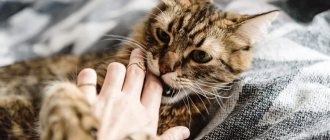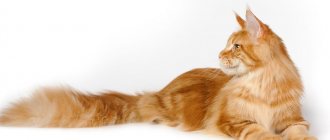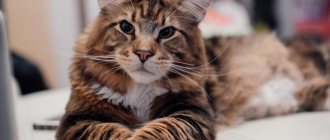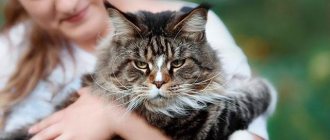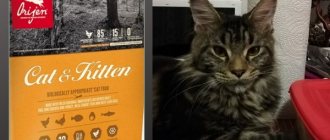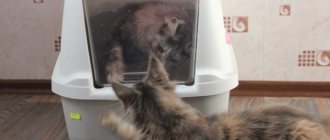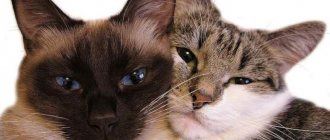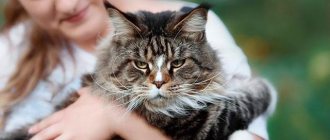The Maine coon breed is distinguished by its large, powerful build, thick coat, and its fluffy tail always delights cat lovers. The first shedding of a Maine Coon occurs at the age of 6-9 months, during this period the baby fur sheds abundantly, and in its place new dense adult hair grows. It is at the age of six months that it is necessary to accustom the kitten to a comb, so that in the future there will be no problems with the combing procedure.
Care and maintenance
The raccoon cat, or Maine Coon, requires special care. If we recall the description of its representatives, they have long hair, large sizes and a good appetite.
Maine Coon
Caring for a Maine Coon is not an easy task, so before you bring such a handsome dog into your home, you should think carefully about whether a person can devote a lot of time and effort to the animal.
This breed has a number of positive traits. These cats are smart, trainable, get along well even with small children, are clean and quickly adapt to the habits and behavior of their owner. The only drawback is the high maintenance requirements.
Basic conditions that must be met:
- Regular cleaning of the eyes from accumulated mucus. It appears even in a completely healthy animal;
- cleaning the ears. The area is quite delicate, so the procedure is carried out carefully so that the animal does not jerk and harm itself. Healthy and clean ears are pink in color, without foreign accumulations;
- the pet's long hair requires daily combing using a special comb;
- Claws should not be allowed to grow to too large a size. Otherwise, they will cause inconvenience to the pet.
Grooming
Cleaning ears, eyes and nose
The Maine Coon's eyes, ears and nose need to be cleaned regularly as dirt and natural secretions accumulate here.
Mucus accumulates in the corners of the eyes, on which various dirt sticks. If these black spots are not removed, they can cause various eye infections. In this case, you will have to contact a veterinarian. It is much easier to prevent such diseases. You can remove it with a cotton sponge dipped in clean warm water or weakly brewed black tea.
The cat's ears require special attention. They are inspected once a week and cleaned if necessary. Healthy ears should have a pink tint.
If during inspection a buildup of sulfur is detected, it must be removed. There are special solutions for this that can be found in zoological stores.
How to feed a Maine Coon so it grows big
American Maine Coon, European Maine Coon
Despite the size of the animal, the stomach of Maine Coon cats is not very large. The option of three meals a day is suitable. For a female, the daily norm is about 250 kcal, and for males 300 kcal. It is worth giving food at the rate of: 30 g of food per 1 kg of weight.
For your information! An adult Maine Coon eats approximately 1.5 times more than a regular breed cat.
In order for the Maine Coon to maintain its correct height and weight, it needs a balanced diet with trace elements and vitamins. Like most cats, representatives of this breed have an excellent appetite, but you should not give them food from the common table.
What diet option can be offered to Maine Coon cats:
- prepared feed;
- self-cooked food;
- mixed type of diet.
What do Maine Coons eat?
A healthy animal will happily eat whatever its owner offers it. Although sometimes there are picky people who refuse dry food or prefer a specific manufacturer.
If the owner prefers to prepare food for his pet himself, then his diet should include:
- meat. Raw beef works well in the mornings and evenings. The pieces are cut into thin slices and given to the animal;
- dairy products. Not only milk, but also cottage cheese, kefir, and grated cheese are provided;
- porridge with milk or water. They improve digestion. In order for your pet to eat them with great pleasure, you should add pieces of boiled meat to them;
- Special vegetables purchased from a pet store are used as a nutritional supplement.
Nutrition
Is dry food suitable for Maine Coons?
Dry food is not prohibited in the diet of Maine Coons, especially if the animal eats it with pleasure. However, this type of feed should not be introduced into the diet on a regular basis. It is best to combine it with homemade food or wet food.
Important! You should not give your pet cheap food like Whiskas or Kitiket on a regular basis. Although they are manufactured using licensed technology, the raw materials used for them are not of the best quality. Such a diet can lead to the development of diseases of the intestines, kidneys, etc.
When offering dry food to your pet, you should give preference to premium options or special food for a specific breed.
Common problems
In order for your pet to grow up affectionate, kind and obedient, it is recommended to educate him from the first days. In the first days, maximum care and love should be shown; starting communication with punishment is not recommended.
Maine Coons are quite intelligent creatures that can do what is asked of them, it is important to convey information to them in a way that they understand.
Common problems and solutions:
- He goes to the toilet past the tray - sit the kitten next to the puddle, say in a serious voice “You can’t!” and move the pet to the place where the tray is.
- Jumps onto the table and other inappropriate places - spray water from a spray bottle into the face, the action is unpleasant for the animal and is perceived as a “Stop” signal.
- Pulled loops on curtains, scratched furniture - when trying to repeat it, the same spray bottle will help.
- If they are chewing on wires, spray them with citrus juice and the animal will avoid the source of the unpleasant odor.
What is prohibited to do
If problems arise, the following rules should be followed:
- do not use force, it is under no circumstances recommended to hit the kitten with your hand or a slipper, otherwise the pet will grow up timid and will perceive the owner as an enemy;
- retroactive punishment - if you discover the consequences of a cat’s pranks after coming home from work, it is not recommended to scold him; the kitten will not understand the reason for the punishment;
- more praise - the animal should be rewarded for even small successes and mistakes should be forgotten.
Maine Coon weight by month
Cocker spaniel: care and maintenance at home
The Maine Coon breed is quite large, which can be seen even in the early stages of the animal’s life. For greater convenience, below is a table of weight by month:
| Age in months | Cat weight | Cat weight |
| 1 | 560-690 g | 630-760 g |
| 2 | 1.16-1.4 kg | 1.22-1.6 kg |
| 3 | 1.6-2.2 kg | 1.9-2.3 kg |
| 4 | 2.6-3.5 kg | 3-3.9 kg |
| 5 | 2.9-4 kg | 3.3-5.4 kg |
| 6 | 3.1-3.9 kg | 3.9-6.4 kg |
| 7 | 3.4-4.2 kg | 4.1-6.5 kg |
| 8 | 3.7-4.2 kg | 4.4-6.8 kg |
| 9 | 4-5 kg | 5-7 kg |
| 10 | 4.1-5.4 kg | 5.1-7.4 kg |
| 11 | 4.2-5.9 kg | 5.6-8 kg |
| 12 | 4.4-6.2 kg | 5.6-9 kg |
Advantages and disadvantages of this breed
The pros and cons of the breed are presented in the table:
| Advantages | Flaws |
| Loyalty to the owner | High price |
| Beautiful appearance | Presence of wool in the house |
| High intelligence | Presence of genetic pathologies |
| Child friendly | High feed consumption |
Maine Coons have significant disadvantages, of course. But there are also many advantages. If you just need a family friend, then a representative of the pet class of any gender would be a good choice.
Animal growth
Labrador: care and maintenance at home
Up to one year of age, kittens develop quite rapidly. By three months, the baby already exceeds the performance of some adult cats of ordinary breeds. In general, the size of a pet depends on many factors.
Important! You should not be upset if the animal does not meet the development standards, but you should still be careful. There is always the possibility that the breeder sold a crossbreed instead of a purebred Maine Coon. When choosing an animal for your family, it is best to contact an official nursery.
Height
Absolutely forbidden
Education does not require special training or much effort. But there are a number of rules that must be followed if a kitten of this breed appears in the house.
First of all, you should take care of the safety of your new pet. The apartment is not a natural environment.
Considering that these animals are characterized by increased curiosity, you cannot:
- Leave the windows open and let your pet out onto an unglazed balcony. The kitten may run away or get injured.
- Grow poisonous plants. If a Maine Coon tastes them, bad consequences should be expected. This also applies to household chemicals and small items such as sewing needles, small pieces of foam rubber or polystyrene. The latter can only be removed surgically.
- Leave electrical cords and wires in the public domain. You should promptly disconnect devices from the network or limit the approach of the animal by any means.
Another thing to consider if you are getting a kitten is how to socialize it. Under no circumstances should you beat or pick him up against his will. Considering the size of these cats, it is not difficult to imagine the kind of injuries they can cause to a person, especially a child.
You cannot deprive them of food and toys. Such measures breed aggression and hostility. These animals value their independence and freedom, so they do not tolerate violence and coercion.
Different requirements by month of life
Caring for and feeding a baby in general is significantly different from caring for an adult pet. This should be taken into account when choosing a diet. You should also monitor the baby’s weight throughout the entire period in order to predict its further development and identify possible shortcomings.
2 months
At this age, babies are already starting to eat on their own and can be taken away from their mother cat. It is worth giving them warm milk and milk porridge. Babies are fed at least 5-6 times a day in small portions, gradually accustoming them to special foods.
By the end of the second month, the kitten will weigh about 1.3-1.5 kg, depending on gender. They already have fairly formed teeth. You can purchase special sticks or toys that your baby will happily chew on.
3 months
By three months, the baby's weight almost doubles. Some boys reach 3 kg. The body stretches out, thick fur grows more and more. It is worth devoting more time to outdoor and active games.
Feeding periods are also maintained up to 5-6 times a day. Gradually the kitten is transferred to special food. You can periodically add dry.
4 months
By this age, babies already eat any food and are accustomed to the tray. However, they remain just as active and playful. At this stage, you can add boiled or scalded meat as complementary food.
6 months
At this stage of life, growth gradually slows down. The animal enters the teenage phase. If the owner does not plan further breeding of offspring, it is recommended to castrate or sterilize the pet at this age.
7 months
The kitten is still growing and by the end of the seventh month gains weight, about 1-1.5 kg. At this stage, kefir, cottage cheese, cheese, and lean meat are added to the diet.
Note! By seven months, the pet's teeth are already fully formed, and he can easily cope with tough food.
Adult cat size and weight
The Maine Coon becomes fully mature and mature by the age of one year. The maximum weight that an adult male can reach is 8-9 kg. In height, as a rule, it does not exceed 25-41 cm from the withers. At the same time, the total length of the body including the tail is up to 100-120 cm. The maximum length of the tail of representatives of this breed reaches 35-37 cm.
Bad behavior
If you have bad character traits, it is recommended to use the principle of prohibition; any physical influence is excluded. The only method for negative reinforcement is a spray of warm water; with its help, the most inquisitive and active cats can be weaned from scratching furniture and jumping on tables.
There are situations that provoke pets to violate order:
- a tray that is not removed or installed in a visible place may force the animal to look for another place;
- the absence of a scratching post will provoke you to look for another place to sharpen your claws;
- lack of attention - the Maine Coon will look for other ways to attract it, as a result you can see broken vases, stolen food, curtains torn from the windows.
Sometimes the owner himself may be to blame for the animal’s bad behavior; if the owner submits to the cat’s obsessive behavior when he begs for food, one can expect the situation to repeat itself many times. Negative reinforcement is just as powerful. If the cat has a habit of tearing the sofa with its claws, it is recommended to secure fabric or double-sided tape to the furniture. To protect furniture, it is also recommended to use odors that are unpleasant for animals (citrus fruits, for example).
Age of castration
Representatives of this breed are ready to breed from the age of 8-10 months. It is for this reason that if the owner of the animal does not plan further breeding, it is best to carry out castration or sterilization.
The need for surgery is determined by the instinct of reproduction. If this is not done, the pet will experience physical discomfort. The male begins to mark the territory by releasing a strong-smelling substance. Cats roll around on the floor, making loud sounds that are unpleasant to human hearing. In addition, this can subsequently lead to the development of various diseases.
Maine Coon Health
The breed is not susceptible to frequent diseases, but their well-being directly depends on proper care and nutrition. An incorrectly selected diet inevitably leads to disruption of the functioning of vital organs.
Note! Representatives of the Maine Coon have a number of ailments that are inherited by them, and a predisposition to certain diseases.
Changing teeth is quite painful for an animal. This starts at four months. During this period, you can notice that the kitten is trying to chew everything that is possible. If the owner knows about this feature, he will be able to take appropriate measures to alleviate the baby’s suffering.
Despite their good health, Maine Coons are not protected from common cat diseases. Gum diseases, problems with the stomach, kidneys, liver, eye diseases, ears, inflammation of the genital organs - all this can be avoided if you properly care for your cat and carry out preventive examinations with a veterinarian.
The Maine Coon breed can sneeze, just like the average person. This can be caused by dust, strong odors, or other irritants such as wool. Prolonged sneezing becomes a reason to visit a doctor.
Important! Vaccinations for children are given according to the established schedule. The first one is placed when the baby is two months old. Before vaccination, you will need to be examined by a specialist.
Regular check-ups with a doctor
Common Cat Diseases
The most common ailments of this breed are:
- digestive tract disorders;
- urolithiasis disease;
- joint diseases;
- infections, inflammations, parasites.
There are also a number of genetic diseases that can manifest themselves both at a young and old age:
- hypertrophic cardiomyopathy is a fairly serious heart disease in which thickening of the stomach wall occurs;
- spinal muscular atrophy. The cause is a recessive gene. The disease causes muscle weakness, due to which the pet will no longer be able to lead an active lifestyle;
- hip dysplasia;
- Polydactyly is less of a disease and more of a natural deformity or physical mutation.
Types of cat houses
The range of cat houses in stores is quite large; it can be difficult for an inexperienced coon owner to choose the right option for his pet. It could be:
- a hammock that can be secured on 4 sides almost anywhere, even under a chair;
- a house in the form of a booth, which is a fabric-upholstered structure with a roof;
- cardboard house of any kind - such products look original, but are not practical.
Also popular are smaller copies of home furniture - beds and sofas for cats.
Beds
One of the simplest options for a cat house. Essentially, it is a thick mattress covered with fabric that can be removed and washed if necessary. Beds can be round, square, rectangular, heart-shaped, etc. It is important that the size of the bed matches the size of an adult cat.
Carrying
There are several types of carriers:
- bag - a carrier made of lightweight fabric with a frame, thick walls and a mesh that allows air to pass through, some models are equipped with small windows;
- a backpack is the most convenient option for travelers, since the owner’s hands remain free;
- plastic container - a stable, ventilated design that is easy to clean;
- cage – designed for transporting cats in transport and is a stable, durable, well-ventilated metal structure.
It is best to have several types of carriers, since each of them is convenient for some purposes and not for others.
Game complexes
These are three-dimensional structures that include everything that a Maine Coon needs for a comfortable life and development: loopholes, stairs, hammocks, a house, scratching posts, toys, etc. Play complexes are a good way to provide your pet with everything necessary and organize his leisure time, but you should understand that they take up a lot of space and are not suitable for installation in a small apartment.
How long do Maine Coon cats live?
The lifespan of a Maine Coon also depends on proper care and nutrition. A healthy lifestyle can give an animal 12-15 years, but there are also centenarians who are 20-22 years old.
Note! One of the features of the breed is that females live approximately 1-1.5 times longer than males.
As you can understand from the article, the Maine Coon is a rather demanding breed of cat. The owner will have to choose the right diet for the pet, brush its thick, long hair daily, and undergo regular checkups with a doctor. However, if a person decides to get a smart, kind, and most importantly, incredibly beautiful animal, then it is best to choose a Maine Coon.
How to structure training sessions
The main principle is consistency. Prohibitions and restrictions for kittens should be repeated regularly in a calm and friendly tone. You cannot voice them as orders. A loud or rude voice will also not produce the desired results.
Exercise should take no more than 15 minutes a day. It will be easier and easier if the animal receives a reward upon completion. It is worth stopping the session if the kitten gets angry or you get angry. A positive attitude during training and after it will speed up the learning process.
